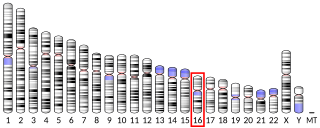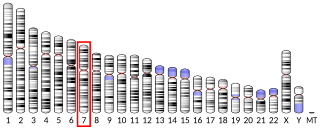
Tetrahydrocannabivarin is a homologue of tetrahydrocannabinol (THC) having a propyl (3-carbon) side chain instead of a pentyl (5-carbon) group on the molecule, which makes it produce very different effects from THC.

Cannabidivarin (CBDV, GWP42006) is a non-psychoactive cannabinoid found in Cannabis. It is a homolog (chemistry) of cannabidiol (CBD), with the side-chain shortened by two methylene bridges (CH2 units).

Neurotrophin-3 is a protein that in humans is encoded by the NTF3 gene.

Interleukin 16 is a pro-inflammatory pleiotropic cytokine. It's precursor, pro-interleukin-16 is a protein that in humans is encoded by the IL16 gene. This gene was discovered in 1982 at Boston University by Dr. David Center and Dr. William Cruikshank.

The granulocyte colony-stimulating factor receptor (G-CSF-R) also known as CD114 is a protein that in humans is encoded by the CSF3R gene. G-CSF-R is a cell-surface receptor for the granulocyte colony-stimulating factor (G-CSF). The G-CSF receptors belongs to a family of cytokine receptors known as the hematopoietin receptor family. The granulocyte colony-stimulating factor receptor is present on precursor cells in the bone marrow, and, in response to stimulation by G-CSF, initiates cell proliferation and differentiation into mature neutrophilic granulocytes and macrophages.

Temafloxacin is a fluoroquinolone antibiotic drug which was withdrawn from sale in the United States shortly after its approval in 1992 because of serious adverse effects resulting in three deaths. It is not marketed in Europe.

Leukotriene C4 synthase is an enzyme that in humans is encoded by the LTC4S gene.

T-cell acute lymphocytic leukemia protein 1 is a protein that in humans is encoded by the TAL1 gene.
The testicular receptor proteins are members of the nuclear receptor family of intracellular transcription factors. There are two forms of the receptor, TR2 and TR4, each encode by a separate gene.

Retinoic acid receptor alpha (RAR-α), also known as NR1B1 is a nuclear receptor that in humans is encoded by the RARA gene.

Testicular receptor 4 also known as NR2C2 is a protein that in humans is encoded by the NR2C2 gene.

Receptor-type tyrosine-protein phosphatase eta is an enzyme that in humans is encoded by the PTPRJ gene.

Transcription factor Maf also known as proto-oncogene c-Maf or V-maf musculoaponeurotic fibrosarcoma oncogene homolog is a transcription factor that in humans is encoded by the MAF gene.

General transcription factor 3C polypeptide 1 is a protein that in humans is encoded by the GTF3C1 gene.

Zinc finger protein 217, also known as ZNF217, is a protein which in humans is encoded by the ZNF217 gene.

Cyclic nucleotide gated channel beta 1, also known as CNGB1, is a human gene encoding an ion channel protein.

Homeobox protein DLX-2 is a protein that in humans is encoded by the DLX2 gene.

Homeobox protein DLX-1 is a protein that in humans is encoded by the DLX1 gene.

Homeobox protein DLX-6 is a protein that in humans is encoded by the DLX6 gene.

Zinc finger and BTB domain-containing protein 7B is a protein that in humans is encoded by the ZBTB7B gene. ZFP67 is an early growth response gene that encodes a zinc finger-containing transcription factor that binds to the promoter regions of type I collagen genes and has a role in development.[supplied by OMIM]
















